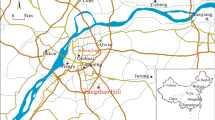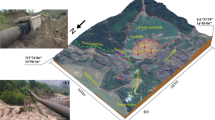Abstract
Extreme heavy rainfall due to Typhoon Talas on September 2–4, 2011 in the Kii Peninsula, Japan, triggered numerous floods and landslides. This study investigates the mechanism and the entire process of rainfall-induced deep-seated landslides forming two massive dams in the Kuridaira and Akatani valleys, respectively. The mechanism of the rapid deep-seated landslides is examined through a series of laboratory experiments on samples from sliding surfaces by using undrained high-stress dynamic-loading ring-shear apparatus. The test results indicate that the failure of samples is triggered by excess pore water pressure generation under a shear displacement from 2 to 7 mm with a pore pressure ratio ranging from 0.33 to 0.37. The rapid movement of landslides is mainly attributed to high mobility due to the liquefaction behavior of both sandstone-rich and shale samples. Geomorphic settings and landslide mobility are major contributing factors to the dam formation. Additionally, shear displacement control tests show that a certain amount of shear displacement between 2 and 7 mm along the sliding surfaces of the gravitationally deformed slopes might have led to the failures. Importantly, computer simulation with LS-RAPID software using input parameters obtained from physical experiments is employed to interpret the entire formation process of the abovementioned two landslide dams. The simulation results are examined in accordance with the observed on-site geomorphic features and recorded data to explain the possibility of sliding processes. The results further point out that local failures are initiated from the lower middle part of the landslide bodies where the geological boundary exists. This condition most probably influences the landslide initiation in the two case studies. This research is therefore helpful for hazard assessment of slopes that are susceptible to deep-seated landslides and other sequential processes in areas with geology and geomorphology similar to that of the Kii Peninsula.

















Similar content being viewed by others
References
Bhandary NP, Yatabe R (2007) Ring shear tests on clays of fracture zone landslides and clay mineralogical aspects. In: Sassa K, Fukuoka H, Wang F, Wang G (eds) Progress in landslide science. Springer, Berlin, Heidelberg, pp 183–192
Chen C-Y and Chang J-M (2016) landslide dam formation susceptibility analysis based on geomorphic features. Landslides 13:1019–1033
Chigira M (2011) Geological and Geomorphological Characteristics of Deep-seated Catastrophic Landslides Induced by Rain and Earthquakes. J Chin Soil Water Conserv 42(4):265–278
Chigira M (2014) Geological and geomorphological features of deep-seated catastrophic landslides in tectonically active regions of Asia and implications for hazard mapping. Episodes 37(4):284–294 December 2014
Chigira M (2015) Geohazards in Asian countries. Proceedings of the 10th IAEG Asian regional conference, Kyoto, Japan, 26–29 Sept. Keynote paper, 7 pages
Chigira M, Tsou C-Y, Matsushi Y, Hiraishi N, Matsuzawa M (2013) Topographic precursors and geological structures of deep-seated catastrophic landslides caused by typhoon Talas. Geomorphology 201:479–493
Chigira M, Kanaori Y, Wakizaka Y, Yoshida H, Miyata Y (2016) Engineering geology. In: Moreno T, Wallis S, Kojima T, Gibbons W (eds) The geology of Japan. The Geological Society, London, pp 457–484
Costa, J.E. and Schuster, R.L. (1987): The formation and failure of natural dams, US Geological Survey, Open-File Report, pp. 87–392
Dunning SA, Mitchell WA, Rosser NJ, Petley DN (2007) The Hattian Bala rock avalanche and associated landslides triggered by the Kashmir earth quake of 8 October 2005. Eng Geol 93:130–144
Ermini L, Casagli N (2003) Prediction of the behaviour of landslide dams using a geomorphological dimensionless index. Earth Surf Process Landf 28:31–47
Ermini L, Casagli N, Farina P (2006) Landslide dams: analysis of case histories and new perspectives from the application of remote sensing monitoring techniques to hazard and risk assessment. Ital J Eng Geol Environ Special Issue 1:45–52
Evans SG (2006) The formation and failure of landslide dams: an approach to risk assessment. Ital J Eng Geol Environ. Special Issue 1. https://doi.org/10.4408/IJEGE.2006-01.S-02
Fan X, Tang CX, van Westen CJ, Alkema D (2012) Simulating dam-breach flood scenarios of the Tangjiashan landslide dam induced by the Wenchuan earthquake. Nat Hazards Earth Syst Sci 12:3031–3044
Fukuoka H, Sassa K, Wang G, Sasaki R (2006) Observation of shear zone development in ring-shear apparatus with a transparent shear box. Landslides 3:239–251
Fukuoka H, Sassa K, Wang G (2007) Shear behavior and shear zone structure of granular materials in naturally drained ring shear tests. In: Sassa K, Fukuoka H, Wang F, Wang G (eds) Progress in landslide science. Springer, Berlin, Heidelberg
Geertsema M, Clague JJ, Schwab J, Evans SG (2006) An overview of recent large catastrophic landslides in northern British Columbia, Canada. Eng Geol 83:120–143
GSI (2011) 10m-DEM data of the Kii peninsula. The Geospatial Information Authority of Japan. http://fgd.gsi.go.jp/download/menu.php
GSJ (1998) Geological map of the Kii peninsula (1:200,000). Seamless Digital Geological Map of Japan, Geological Survey of Japan, 1998. https://gbank.gsj.jp/geonavi/
Hayashi S, Uchida T, Okamoto A, Ishizuka T, Yamakoshi T, Morita K (2013) Countermeasures against landslide dams caused by Typhoon talas 2011. Asia-Pacific Tech Monitor 30(1, Jan-Mar 2013):20–26
Huang R, Pei X, Fan X, Zhang W, Li S, Li B (2012) The characteristics and failure mechanism of the largest landslide triggered by the Wenchuan earthquake, may 12, 2008, China. Landslides 9:131–142
JMA (2011) Hourly rainfall data at Kitayama Station. Japan meteorological agency. http://www.data.jma.go.jp/gmd/risk/obsdl/index.php
Kilburn CRJ, Petley DN (2003) Forecasting giant, catastrophic slope collapse: lessons from Vajont, northern Italy. Geomorphology 54:21–32
Kojima S, Nagata H, Yamashiroya S, Iwamoto N, Ohtan T (2015) Large deep-seated landslides controlled by geologic structures: prehistoric and modern examples in a Jurassic subduction–accretion complex on the Kii Peninsula, central Japan. Eng Geol 186:44–56
Korup O (2002) Recent research on landslide dams – a literature review with special attention to New Zealand. Prog Phys Geogr 26(2):206–235
Korup O (2005) Geomorphic hazard assessment of landslide dams in South Westland, New Zealand: fundamental problems and approaches. Geomorphology 66:167–188
Miyagi T, Yamashina S, Esaka F, Abe S (2011) Massive landslide triggered by 2008 Iwate-Miyagi inland earthquake in the Aratozawa dam area, Tohoku, Japan. Landslides 8:99–108
MOI (2014) Report on jure landslide, Mankha VDC, Sindhupalchowk District, Nepal government Ministry of Irrigation, august 24, 2014, 29 pages in English
Peng M, Zhang L-M (2012) Breaching parameters of landslide dams. Landslides 9(1):13–31
Petley DN, Allison RJ, (1997) The mechanics of deep-seated landslides. Earth Surf Process Landf 22(8):747–758
SABO (2013) A pamphlet released in October, 2013 on Overview of the 2011 disaster induced by Typhoon No. 12, Implementation of an urgent investigation and countermeasures to disaster areas. The Kii Mountain District SABO Office, Kinki Regional Development Bureau. The Ministry of Land, Infrastructure, Transport and Tourism. http://www.kkr.mlit.go.jp/kiisanchi/outline/, 24 pages (in Japanese)
SABO (2014a) A PDF document dated in July, 2014 on Deep-seated landslides occurred during Typhoon No.12 in September 2011 in Kuridaira area. The Kii Mountain District SABO Office, Kinki Regional Development Bureau. The Ministry of Land, Infrastructure, Transport and Tourism, 8 pages (in Japanese)
SABO (2014b) A PDF document dated in July, 2014 on Deep-seated landslides occurred during Typhoon No.12 in September 2011 in Akatani area. Kii Mountain District SABO Office, Kinki Regional Development Bureau. The Ministry of Land, Infrastructure, Transport and Tourism, 23 pages (in Japanese)
SABO (2015) DEM data and reports on the investigation of the 2011 landslide disasters offered by the Kii Mountain District SABO Office
Sassa K (1996) Prediction of earthquake induced landslides. Proceedings of 7th International Symposium on Landslides, AA Balkema, Trondheim, Vol. 1, pp. 115–132
Sassa K (2005) Landslide disasters triggered by the 2004 mid-Niigata prefecture earthquake in Japan. Landslides 2:135–142
Sassa K, Fukuoka H, Wang G, Ishikawa N (2004) Undrained dynamic-loading ring-shear apparatus and its application to landslide dynamics. Landslides 1(1):7–19
Sassa K, Nagai O, Solidum R, Yamazaki Y, Ohta H (2010) An integrated model simulating the initiation and motion of earthquake and rain induced rapid landslides and its application to the 2006 Leyte landslide. Landslides 7(3):219–236
Sassa K, Dang K, He B, Takara K, Inoue K, Nagai O (2014) A new high-stress undrained ring-shear apparatus and its application to the 1792 Unzen-Mayuyama megaslide in Japan. Landslides 11(5):827–842
Setiawan H (2017) Landslide hazard assessment on the upstream of dam reservoir. PhD thesis. Kyoto university
Stefanelli C. T, Segoni S, Casagli N and Catani F (2017) Assessing landslide dams evolution: a methodology review. Advancing culture of living with Landslides, pp. 253–258
Tien P. V, Sassa K, Takara K, Dang K, Luong LH and Ha ND (2017) Simulating the formation process of the Akatani landslide dam induced by rainfalls in Kii peninsula, Japan. Advancing culture of living with Landslides, pp. 497–506
Tien P. V, Sassa K, Takara K, Fukuoka H, Khang D, Shibasaki T, Hendy S, Ha N. D and Luong L. H (2018) Mechanism of large-scale deep-seated landslides induced by rainfall in gravitationally deformed slopes: a case study of the Kuridaira landslide in Kii peninsula. Landslide dynamics: ISDR-ICL landslide interactive teaching tools, springer international publishing, doi:https://doi.org/10.1007/978-3-319-57777-7_52
Tsou C-Y, Feng Z-Y, Chigira M (2011) Catastrophic landslide induced by Typhoon Morakot, Shiaolin, Taiwan. Geomorphology 127(3–4):166–178
Wang F, Hayashi H, Okeke AC, Mitani Y, Yang H, Kuwada Y, Baba S (2014) Using microtremor Array survey to evaluate the possibility of piping-induced landslide dam failure. Landslide Sci Safer Geoenvironment 3:649–657
Yamada M, Matsushi Y, Chigira M, Mori J (2012) Seismic recordings of landslides caused by typhoon Talas (2011), Japan. Geophys Res Lett 39:L13301
Acknowledgments
This research was financially supported by the Leading Graduate School Program on Global Survivability Studies (GSS Program) in Kyoto University. The authors would also like to express our special thanks to Mr. Hayashi, vice-director of the Kii Mountain District Sabo Office, Ministry of Land, Infrastructure, Transport and Tourism, for sharing a number of relevant data including DEM data, drawings, and reports. In particular, we are immensely grateful to Mr. Ogawauchi (senior engineer at Japan Conservation Engineers & CO., LTD.) for his support and valuable comments during the site survey. We deeply acknowledge their support during this study.
Author information
Authors and Affiliations
Corresponding author
Rights and permissions
About this article
Cite this article
Van Tien, P., Sassa, K., Takara, K. et al. Formation process of two massive dams following rainfall-induced deep-seated rapid landslide failures in the Kii Peninsula of Japan. Landslides 15, 1761–1778 (2018). https://doi.org/10.1007/s10346-018-0988-y
Received:
Accepted:
Published:
Issue Date:
DOI: https://doi.org/10.1007/s10346-018-0988-y




